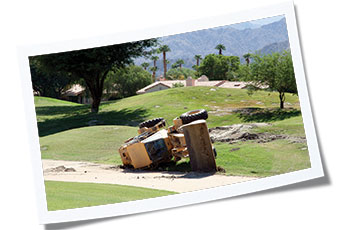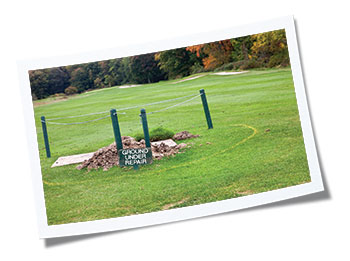What to do when OSHA comes knocking

Photo: iStock.com/lisafx
The No. 1 cause of job-related deaths on golf courses is machinery rollovers. Nationwide, 18 of the 48 deaths in the latest Occupational Safety and Health Administration (OSHA) reporting period were caused by equipment rolling over on a worker.
And yes, one golf course employee was killed last year by a golf ball. And while it may sound like the punchline to a bad joke, it was no laughing matter to his family, his course or to the inspectors at OSHA.
Rounding out the top five causes of work-related deaths on golf courses are being struck by carts or vehicles; falls; being struck by tree limbs; and Mother Nature. In that last category, deaths from heat stroke accounted for 4 percent of work-related golf course deaths.
OSHA’s job, according to Howie Eberts, inspector in OSHA’s Northern Ohio office, is to help employers eliminate job-site accidents and deaths. Eberts emphasizes that OSHA inspectors do not have a “gotcha” mentality. However, the law does provide them with tools to attract the attention of any employer. And every employer should have a safety training program in place.
Start with the newbies
“New employees are six times more likely to be injured than experienced workers who know the grounds,” says Michael Pate, Nationwide Insurance associate professor of safety and health at Penn State University.
He recommends a walk-through with all workers to identify high-risk operating areas like steep slopes, retaining walls and bunker faces. While manufacturers typically use a 15-percent slope as a safety threshold, Pate says even the slightest slope is not safe. “Be sure people know where the significant risks are and how to mitigate them,” Pate says.
One way to cut injuries is to have a policy to keep mowers two machine widths from a drop-off. Although grass height often dictates the machine used, when possible, use a walk-behind or string mower on risky slopes.
Workplace injuries are expensive. The average workers’ compensation medical claim in 2016 was approximately $29,100, according to actuaries at State Farm Insurance.

Photo: iStock.com/chimmy
It’s worse on management if there is a job-site violation involved in an accident. The average fine levied on golf courses nationwide since 2016 is $5,000. It varies from location to location. In Ohio, the figure averaged $2,200 per citation in that same period.
Fines go as high as $12,900 for a first offense. However, reductions are possible if the course shows willingness to work with inspectors and remedy the situation promptly. Keep in mind that while serious injury or death will compel an inspection, OSHA workers can show up at any course or other worksite at any time.
Fines for serious or repeated violations are much stiffer. The average fine since 2016 for serious offenses is $12,934. Fines for repeated violations of OSHA safety regulations can run as high as $129,340. That would put a dent in any course’s operating budget.
What OSHA does
OSHA’s inspectors are trained to look for job-site safety hazards. Not every employer rolls out the red carpet when OSHA comes knocking. In fact, one roofer’s license plate reads “FUOSHA,” which probably does not refer to an obscure village in Japan. Eberts showed a photo of the plate to superintendents at the Ohio Turf Show, where he also showed photos of multiple red flags that grab an inspector’s attention at any country club or public course.
Eberts notes that across all OSHA inspections, 82 percent of problems can be placed into one of four categories: struck by; falls; caught between; and electrocution.
It’s not unusual to see a course employee up on an articulating boom. The law says that anyone working above 6 feet must have fall protection. “You must have a harness or rail,” Eberts states. Every employee, within a couple of days of starting the job, should be aware of such restrictions as part of a worker safety orientation.
Even getting up on a roof presents opportunity for injury. OSHA regulations say ladders must extend 3 feet above the top surface the worker is accessing.

Photo: iStock.com/Johnrob
It’s not just going up that’s an issue — going down is, too.
Open trenches present a major hazard. “Trenches are a problem,” Eberts says. Any trench 5 feet or deeper must be shored up. “One cubic yard of soil weighs more than a Volkswagen,” Eberts notes. A trench landslide will trap a worker, perhaps fatally.
Most insurance companies offer advice and evaluation of job sites with an eye to reducing potential issues. In every case, analysts agree that management buy-in is vital. This includes everyone in the chain, from greens committee members who might balk at delays or the expense of changes to the superintendent and the crew chiefs. Of course, employees must be part of the process since they’re the ones who need to be aware of changing situations.
Pate advises being sure new workers can operate equipment on level ground before moving to riskier areas. “Avoid jerky operation that can cause shifts in weight,” he says. “Keep equipment low, operate at a slow speed, be sure stop/starts are smooth and use safety equipment.”
These guidelines should be part of any program, printed out and stored in a binder in the maintenance shed and reevaluated regularly.
Something as routine as a skid-steer loader can become a safety issue. “Don’t stack pallets (on a fork) so high that the driver can’t see over them,” Eberts says. It’s not uncommon for a worker on the ground to be caught between a loader and a pile of flats or another piece of equipment. Such injuries fall into either the “struck by” or the “caught between” category.
Once all those materials are in place, Eberts advises superintendents to be mindful of damage to storage racks. Check them frequently for mechanical damage, rust, overweighting and unbalanced loading. Nothing triggers a disaster like an overloaded shelf of chemicals or parts collapsing on a worker.
And if you think that’s cringeworthy, consider that OSHA hears of four people per year who go through chippers (this includes chippers used in all businesses, including landscaping). “Nothing is left but what is blown into the truck,” Eberts says. Branches have a bad habit of grabbing a worker’s jacket or shirt and pulling them into the machine.
What you must report
No matter how horrific or mundane the cause of a worker’s death at a golf course, OSHA must be notified. “Even if it is a heart attack, you have to report every death at work,” Eberts emphasizes.
An employer also has to report any hospitalization for work-related treatment within 24 hours of the incident. While your mind and thoughts might be with the worker, they also have to be with OSHA’s reporting requirements.
“If a worker goes to the ER for stitches, no, you don’t have to report it,” Eberts says. “If they’re admitted overnight, you do.” Note the incident in the safety binder.
The club’s OSHA compliance statement should be brief, to the point and understandable by all workers (see sidebar). This includes Spanish-speaking workers or workers who might have trouble reading at all. While exceptional incidents grab headlines, there are a scattering of other death causes that, when a superintendent thinks about them, are not all that strange on a golf course.
For example, electrocution in a water-filled trench is understandable when one walks irrigation lines. While ghastly, having a lawn mower roll over, pinning the operator underwater in a pond is not unthinkable. In fact, both incidents happened recently at different clubs.
If an incident occurs, it must be documented, and all employees involved should be debriefed. The supervisor should listen to employee suggestions for improvement, as well as offer guidance for avoiding a repeat accident.
Three-wheel devices can be especially tricky. Some bunker equipment lacks a rollover protection system (ROPS). Perhaps counterintuitive is Pate’s advice not to use a seat belt on machines without ROPS. Not being strapped in gives the operator a chance to jump off or crawl out from under a rolled machine.
Lastly, Pate advises a written policy forbidding operation of machinery under the influence of alcohol or other substances.
The odds of having an incident befall a club will be reduced by planning, awareness and record keeping. Sticking a copy of this article in the club’s safety policy binder will help demonstrate that the course is aware of the need for safety and has made safety part of everyday operations.
What to put in an OSHA binder
Among the kind of information that should be included in a club’s OSHA compliance program documents are:
- A statement that OSHA compliance is club policy
- Contact info for the safety program director
- Names of members on the club’s safety committee, which advises about hazards but does not have executive authority
- First aid and emergency planning scheme
- Employee training protocols, including a record of session dates and what was covered
- Self-inspection procedures
- Incident records










